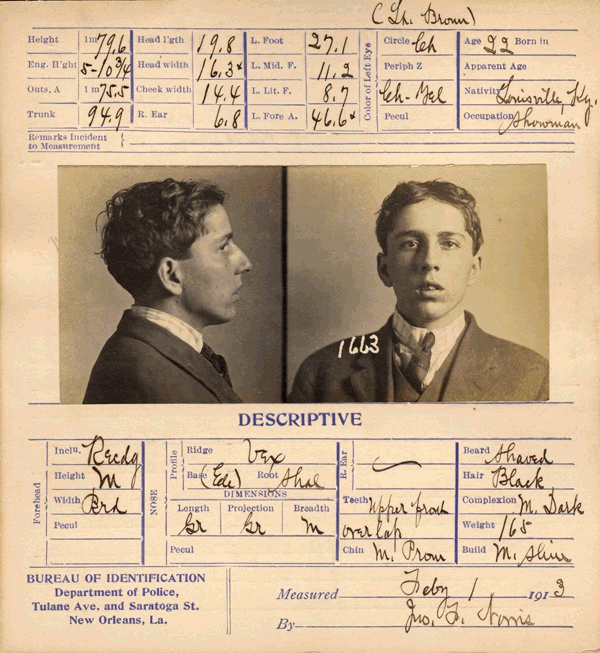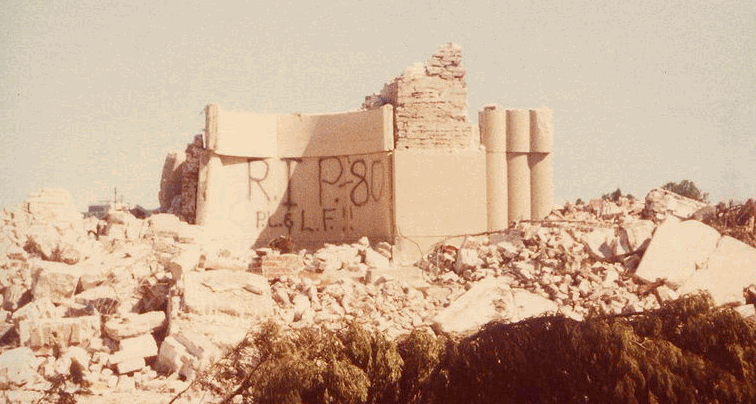|
Today in New Orleans History |
|
|
December 8


NOPD Adopts
Bertillon (Mug Shot) System The use of mug shots to aid in criminal identification became common practice
in the late 19th century. Police departments, both in the United States and abroad, began to develop "rouges galleries"
and to gather information about the perpetrators to accompany the photographs. In the early 1880s, French criminologist Alphonse
Bertillon systematized and expanded the "science" of using photographs for identication purposes. "Bertillonage,"
in addition to photographing suspects (front and right profile shots), involved the gathering of precise physical measurements
(height, weight, size of head, length of forearm, torso, ear, feet, etc.) and description (of scars, moles, tattoos). Although
the Bertillon method was widely used, it was supplanted eventually by fingerprinting -- a much more precise and unambiguous
method of identification. Financial statements in the NOPD annual reports list expenditures for "photographs of
prisoners" as early as 1894, and subsequent reports refer to the "Rogues Gallery" and the department's effort
to update and maintain it. The force adopted the Bertillon system on December 8, 1896. Copies of the Bertillon
cards were sent to the National Bureau of Identification (the forerunner of the FBI) in Chicago (later, in Washington D.C.)
and to police departments around the country. The 1899 Annual Report notes that the combined system of Rogues Gallery and
Bertillon cards "has been of the greatest value to this department, as many offenders were arrested and identified by
this positive and thorough method. . . ." The system was relatively short lived, however; although the collection includes
mug shots taken in the 1920s, the Bertillon cards stop ca. 1919. Image and text from the New Orleans Public Library
|
||
|
Drew Brees became the fifth NFL quarterback in NFL history
to reach 50,000 yards passing on Monday, Sunday, December 8, 2013.
On December 8, 1976 Jeff Beck with the Jan Hammer Group and the Climax Blues Band performed at A Warehouse. Interstate 10 at Joffre Road on December 8, 1966. Photographer C. Bennette Moore died in New Orleans on December 8, 1939.
His photographs have helped chronicle the history of our city.
The newly reconstructed New Orleans Fairgrounds race course opened on December 8, 1907.
A fired had destroyed the old grandstand of the oldest race course in the United States.
Since the capture of New Orleans durng the Civil War, no elections were held until the qualifications
for voting were made contingent under the production of amnesty oaths required in the presidential proclamations of
December 8, 1863. It was understood that all those who were excluded for any reason from the benefit of the
amnesty oaths would not be permitted to vote unless specially pardoned by the President. May 12th, 1865
was the day fixed for the election of Mayor and all other city officials. The campaign was interesting because it witnessed
the appearance of the National Democratic and of the Democratic Conservative parties. This ended the Military appointees by
the federal government. The schooner Nuestra Señora del Cármen, owned by Don Prospero Ferrayolo was used as a temporary
jail during the period December 10, 1794 to February 26, 1895 after the great fire of of
December 8, 1794 destroyed the royal jail along with hundreds of other buildings in the city. Last Saints Game at Tulane Stadium Ground
was broken for Tulane stadium on April 7, 1924. It opened on October 23, 1926 with a seating capacity of roughly
35,000. New Orleans-Item sports editor Fred Digby popularized the term "Sugar Bowl" in 1927. The first Sugar Bowl
game was played there on January 1, 1935, against the Philadelphia Temple Owls. The last was on December 31, 1974 when
Nebraska beat Florida 14-10. In 1947 the stadium was expanded to accommodate 80,985 fans. Lights were installed in 1957.
It was the home of the Saints, from their first game on September 17, 1967 when John Gilliam returned the opening
kickoff 94 yards for a touchdown (but they lost 27-13 loss to the Los Angeles Rams) until December 8, 1974 when they won 14-0
over the St. Louis Cardinals. On November 8, 1970, Tom Dempsey made his record-breaking 63-yard field goal there, pushing
the Saints into a 19-17 win over the Detroit Lions. The record attendance of
86,598 was set on December 1, 1973, during the last game played by LSU against Tulane in the Sugar Bowl. Tulane defeated LSU
14-0, ending a 25-year winless streak against LSU. The last game ever played in Tulane
Stadium was between De La Salleand Rummel on November 1, 1979. The last point scored in Tulane Stadium History was by Rummel
High place kicker Gary Boudreaux. The stadium was under demolition from November 18, 1979 through June 15, 1980.
(Photo by Infrogmation, 1980) |
|
|
|

To receive an update for each day in New Orleans history,
join our facebook page - Today in New
Orleans History.
Analytics |
||

 Among the New Orleans Police Department records deposited in the City Archives are several thousand mug shots of individuals
arrested in the city ca. 1900 to 1925. The NOPD records also include some 700 "Bertillon cards" and several thousand
glass negatives used to create mug shots.
Among the New Orleans Police Department records deposited in the City Archives are several thousand mug shots of individuals
arrested in the city ca. 1900 to 1925. The NOPD records also include some 700 "Bertillon cards" and several thousand
glass negatives used to create mug shots. 
 Tulane Stadium was the site of three of the first nine Super Bowls -- Super Bowls IV in 1970, VI in 1972, and IX in 1975.
Super Bowl IX was the final professional league game ever played at the stadium. It would become one of three stadiums which
hosted a Super Bowl and are no longer standing. Tampa Stadium (which hosted two Super Bowls) was demolished in April 1999
and the Orange Bowl (which hosted five Super Bowl games) was demolished in September 2008.
Tulane Stadium was the site of three of the first nine Super Bowls -- Super Bowls IV in 1970, VI in 1972, and IX in 1975.
Super Bowl IX was the final professional league game ever played at the stadium. It would become one of three stadiums which
hosted a Super Bowl and are no longer standing. Tampa Stadium (which hosted two Super Bowls) was demolished in April 1999
and the Orange Bowl (which hosted five Super Bowl games) was demolished in September 2008. 




